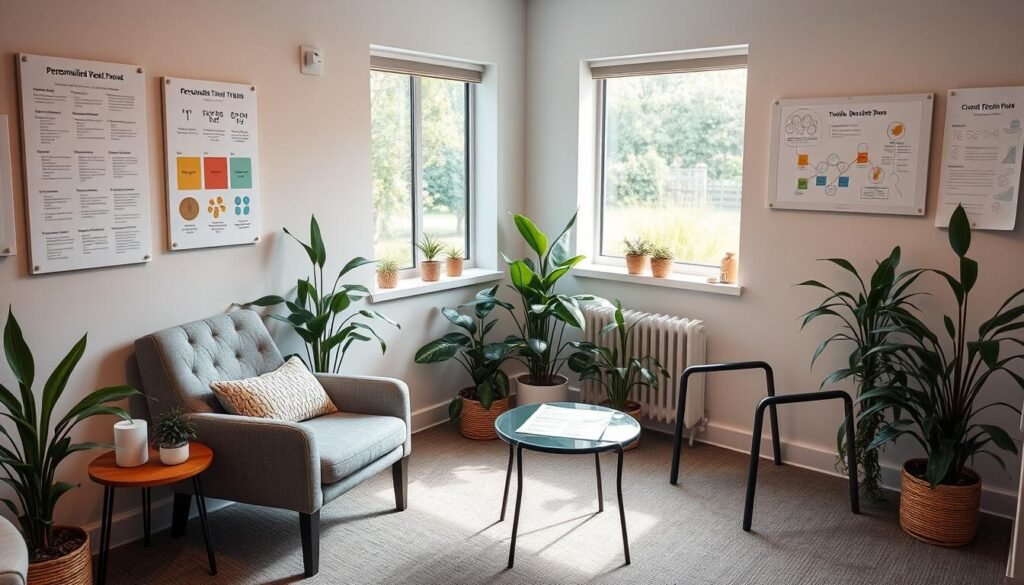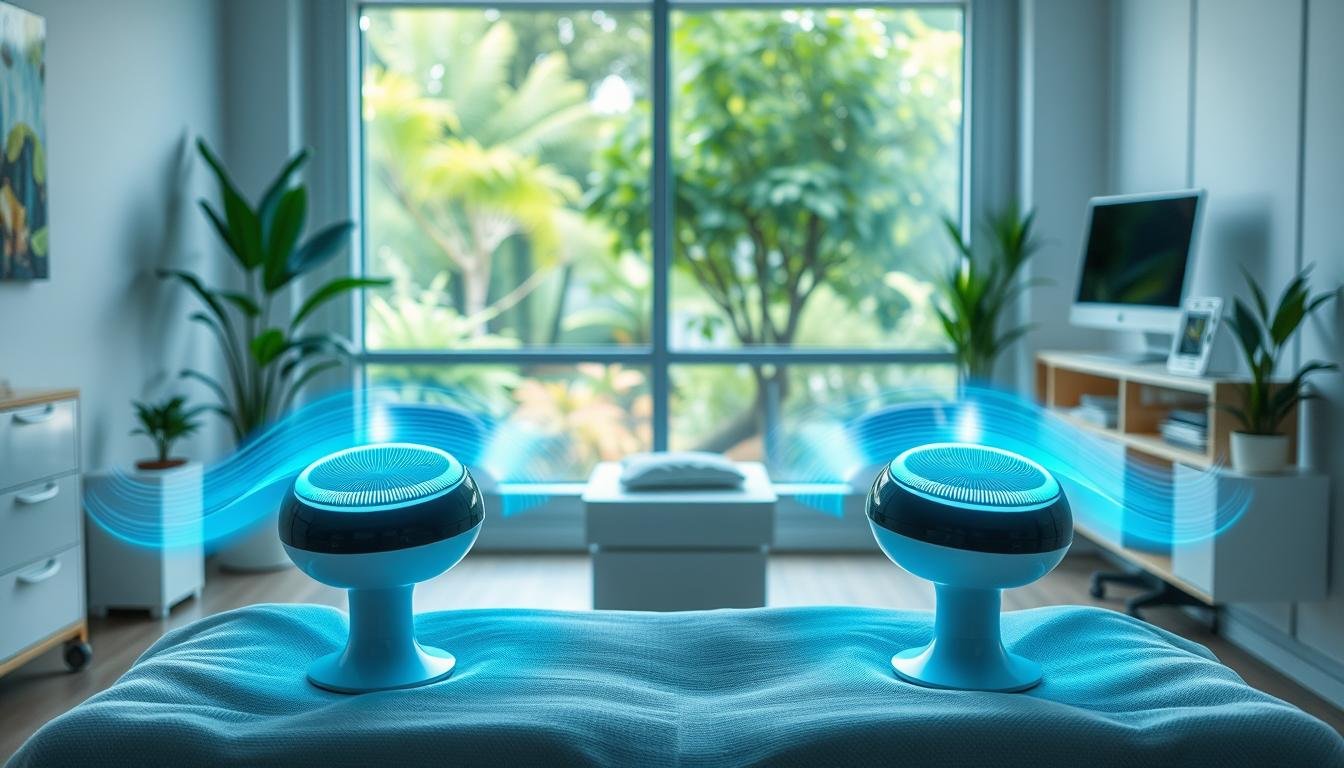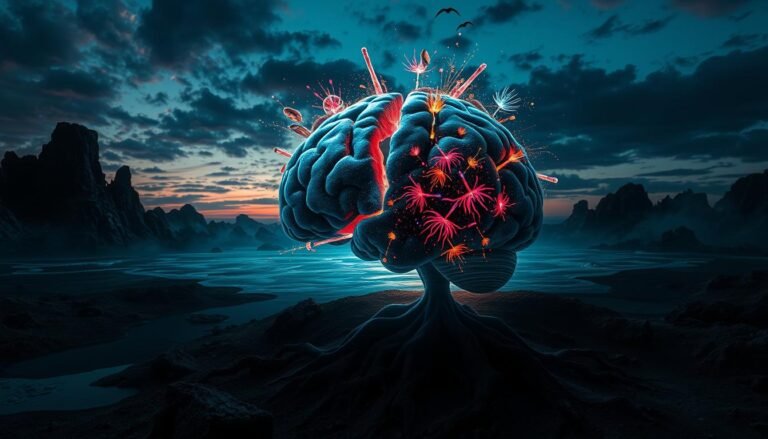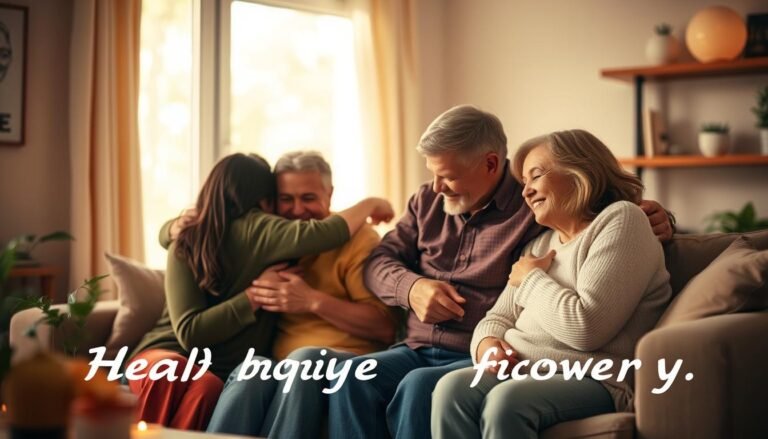Discover Groundbreaking Addiction Treatments
I’m excited to share the latest in addiction treatment. This field is always changing with new treatments and research. I’ve been following neuroscientists and researchers. They’re working on new therapies to help people with substance use disorders.
There are only 4 medicines for addiction treatment now. We need more and better solutions. Researchers like Dr. Travis Baker are using transcranial magnetic stimulation (TMS) to help. They’re also using artificial intelligence and brain biomarkers to improve treatment.
Key Takeaways
- Innovative approaches to addiction treatment are being developed, including new medications and therapies.
- Groundbreaking research is being conducted to improve our understanding of addiction and develop more effective treatments.
- Technological advancements, such as virtual reality therapy and teletherapy, are expanding accessibility for individuals seeking assistance.
- Genetic screening and personalized treatment plans can enhance the efficacy of treatment and increase the success rate of addiction recovery.
- Holistic approaches to recovery, such as meditation and nutritional therapy, can complement traditional treatments and support long-term recovery.
My Journey Through Modern Addiction Treatment Options
I explored many modern ways to treat addiction. I learned that knowing the latest treatments is key. A mix of treatments is best for lasting sobriety. I looked into medication, therapy, and support groups.
Every year, over 15 million Americans struggle with alcohol use disorder. About 5 million are women. This shows we need good treatments. A full recovery plan is important for body, mind, and spirit.
Books like “Drinking: A Love Story” by Caroline Knapp and “Beautiful Boy” by David Sheff share addiction’s struggles. They show the need for help and treatment options. The FDA has approved drugs like naltrexone and buprenorphine. The Mental Health Parity Act also helps with coverage.
I’ve seen how treatment methods keep changing. It’s vital to keep up with new methods. By trying different treatments, people can find lasting sobriety and better health.
| Addiction Treatment Options | Description |
|---|---|
| Medication | Naltrexone, buprenorphine, and other medications approved by the FDA |
| Behavioral Therapy | Cognitive-behavioral therapy, contingency management, and other forms of therapy |
| Support Groups | 12-step programs, peer support groups, and other forms of community support |
Revolutionary Approaches in Behavioral Therapy
In the world of addiction treatment, we need new ways to tackle behavioral therapy. Traditional methods focus on symptoms, but revolutionary approaches aim to find the root causes. Deep brain stimulation (DBS) is one such method. It targets brain circuits linked to drug addiction.
DBS in addiction treatment is a big step forward. It can change brain areas to lessen cravings and boost well-being. This revolutionary approach to behavioral therapy could change how we treat addiction. It’s an area of research that’s both exciting and promising.
Some key benefits of revolutionary approaches in behavioral therapy include:
- Targeted treatment of underlying causes of addiction
- Reduced cravings and improved overall well-being
- Potential for long-term recovery and reduced relapse rates
As research grows, it’s clear that behavioral therapy is key in fighting addiction. By embracing revolutionary approaches and staying ahead in innovation, we can make addiction treatment better and more accessible for everyone.
| Treatment Approach | Benefits |
|---|---|
| Deep Brain Stimulation (DBS) | Targeted treatment of underlying causes of addiction, reduced cravings and improved overall well-being |
| Cognitive Behavioral Therapy (CBT) | Helps individuals identify and change negative thought patterns and behaviors |
The Science Behind New Medical Interventions
Exploring the world of medical interventions, I’m amazed by the quick progress. New medicines and treatments for the brain are being created fast. This gives hope to those fighting addiction. Artificial intelligence is helping find new uses for drugs, leading to new treatments.
Some key areas of research include:
- Genetic-based therapies, which offer personalized treatment plans tailored to an individual’s specific needs
- Neurological treatment approaches, which aim to repair and restore damaged brain function
- Medical interventions, such as medication-assisted treatment and behavioral therapy, which are being used in combination to achieve better outcomes
Understanding the science behind new treatments is vital. Keeping up with research helps people make smart choices about their care. Personalized treatment plans are key, as they offer custom support and guidance.
As research grows, we’ll see more new treatments and medicines. The future of fighting addiction is bright and full of hope. By staying informed, we can help create a healthier world for everyone.
| Medical Intervention | Description |
|---|---|
| Genetic-based therapies | Personalized treatment plans tailored to an individual’s specific needs |
| Neurological treatment approaches | Repair and restoration of damaged brain function |
| Breakthrough medications | New and innovative medications being developed to treat addiction |
Digital Solutions Transforming Recovery
Exploring addiction treatment, I see how digital solutions are changing recovery. The COVID-19 pandemic pushed us to use digital tech more. Now, people can get addiction treatment from home.
Using digital solutions makes getting help easier. Mobile apps and online sites offer tools and resources. They help track progress and connect with support groups.
Some big pluses of digital solutions in recovery are:
- More people can get addiction treatment
- Support is flexible and easy to get
- It’s easier to connect with others for support
Looking ahead, digital solutions are key in recovery. They help us reach more people with addiction treatment. With the right tech, we can make recovery better and more accessible for everyone.
Holistic and Alternative Treatment Breakthroughs
My journey to understand addiction has shown me the value of holistic and alternative treatments. These methods tackle addiction’s physical, emotional, and spiritual sides. They offer a deeper healing approach than traditional methods.
Mind-body integration is a key part of holistic treatment. It includes meditation, yoga, and deep breathing. These activities help reduce stress and anxiety, aiding in recovery. For instance, studies have found yoga benefits older women at risk of Alzheimer’s. It also boosts lung function in adults with asthma.
Natural Healing Approaches
Natural healing methods like acupuncture and herbal medicine are also vital. They help improve health and lower relapse risk. Common herbal remedies include:
- Ginkgo biloba, which may improve early cognitive recovery after an ischemic stroke
- Kencur ginger, which has been found to possess anti-cancer properties
- Skullcap, which contains anti-cancer compounds suitable for modern medicinal applications
It’s important to use these alternative methods alongside traditional medicine. A well-rounded treatment plan combines both for the best results.
Lifestyle Modification Programs
Lifestyle programs support recovery by promoting healthy habits. This includes diet-based therapies and relaxation techniques. By adding these holistic methods to a treatment plan, recovery can be more effective and lasting.
| Approach | Benefits | Risks |
|---|---|---|
| Mind-body integration | Reduces stress and anxiety, promotes overall well-being | None reported |
| Natural healing approaches | Promotes overall health and well-being, reduces risk of relapse | Potential herb-drug interactions, side effects, and contraindications |
| Lifestyle modification programs | Promotes healthy habits and routines, supports recovery | None reported |
Personalized Treatment Plans: The New Standard
Exploring addiction recovery, I’ve learned how vital personalized treatment plans are. These plans are made just for each person, focusing on their unique needs. They use genetic testing and other methods to help people recover better.
In recent years, healthcare has moved towards personalized treatment big time. Data has grown by 48% every year. In addiction recovery, tailored approaches are now the norm. This means treatment centers can offer more effective help for those fighting addiction.
Some big pluses of personalized treatment plans are:
- They tackle addiction’s root causes better
- They boost recovery success rates
- They lower relapse risks
- They improve overall health
Technologies like CRISPR and next-gen sequencing help predict disease risks and treatment outcomes. Pharmacogenomics also helps tailor therapies and avoid bad drug reactions. These advances in personalized medicine are changing addiction recovery, bringing new hope to those seeking help.

Looking ahead, it’s clear personalized treatment plans are the future in addiction recovery. They offer tailored approaches to help people recover better and feel better overall. With new tech and care tailored to each person, we’re moving towards a more effective and caring way to tackle addiction.
Breaking Ground: Virtual Reality in Addiction Recovery
Virtual reality is changing how we treat addiction. It offers therapy sessions and tools to manage cravings. People can practice coping skills in a safe space.
Studies show virtual reality can lower relapse rates. For example, approach-avoidance training (AAT) helps those struggling with alcohol. It lets people face temptations in a controlled way, building confidence and skills.
Immersive Therapy Sessions
These sessions let people face their addiction in a virtual world. With therapists, they can create their avatar and interact with coaches. This helps improve mood and reduce cravings.
Craving Management Through VR
VR is also used to manage cravings. It simulates real-life situations, helping people practice coping skills. This method has shown to reduce relapse rates and improve recovery outcomes.
| Study | Method | Results |
|---|---|---|
| Approach-avoidance training (AAT) | Virtual reality-based training | Reduced relapse rates for alcohol dependency |
| Virtual reality-based craving management | Simulation of real-life scenarios | Improved coping skills and reduced cravings |
Remote Treatment Possibilities
VR also makes treatment more accessible. It offers remote options for those far from treatment centers. This could lead to better treatment adherence and recovery outcomes.
Community Support Evolution
As I explore addiction recovery options, I’ve learned how key community support and social connections are. Community support is changing, with more people seeing the value of social ties in recovery.
Support groups and online forums offer a sense of belonging and connection. They help keep people motivated and involved in their recovery. For instance, some groups provide:
- Safe spaces for sharing experiences
- Chances to meet others facing similar challenges
- Support and encouragement from peers

Online forums and social media also help build a sense of community. They offer a wealth of information and support. This helps strengthen addiction recovery and social connections.
| Resource | Description |
|---|---|
| Support Groups | Safe spaces for individuals to share their experiences and connect with others |
| Online Forums | Platforms for individuals to access information, support, and guidance |
| Social Media | Tools for individuals to connect with others and access recovery-related resources |
Understanding Insurance Coverage for New Treatments
Exploring addiction treatment, I’ve learned how key insurance and financial help are. New rules have made getting help easier and cheaper. In the U.S., the California Department of Insurance (CDI) makes sure health plans cover important treatments, like for addiction.
It’s vital to know what your insurance does and doesn’t cover for addiction. Preventive care coverage includes tests and vaccines that keep you healthy. Mental health and addiction services must be covered in California, helping people fight addiction.
Understanding insurance can be tough, but there are tools to help. You can use the Summary of Benefits and Coverage, cost estimators, and doctor finders. These tools help figure out what’s covered and what might cost you. Plus, there are programs to help pay for treatment, making quality care more accessible.
Recent Policy Changes
New rules have made it easier to get insurance for addiction treatment. The Affordable Care Act (ACA) makes sure plans cover essential treatments, including for addiction. This change has led more people to seek help, showing the need for good insurance and financial aid.
Coverage Options
What your insurance covers for addiction treatment varies. Some plans offer a lot of services, while others might not. It’s important to check your plan and ask questions to know what’s included.
Financial Assistance Programs
There are programs to help pay for addiction treatment. They can cover treatment costs and other expenses, like getting to treatment. By looking into these options and understanding insurance, you can get the help you need to beat addiction and recover fully.
Conclusion: Your Next Steps Toward Recovery
Starting yourrecovery journey shows your strength and resilience. Thenext steps might look tough, but you can do it with the right help. You’ll find confidence as you move forward.
Getting professional help is a keyaddiction treatment step. You might need a therapist, counselor, or support group. Having a team that cares about your well-being is very important.
Explore different treatment options like medication-assisted therapies or holistic approaches. Find what works best for you.
Recovery is unique for everyone. Be kind to yourself, celebrate small wins, and ask for help when needed. With determination and a desire to learn, you can beat addiction and start a new, free life.






